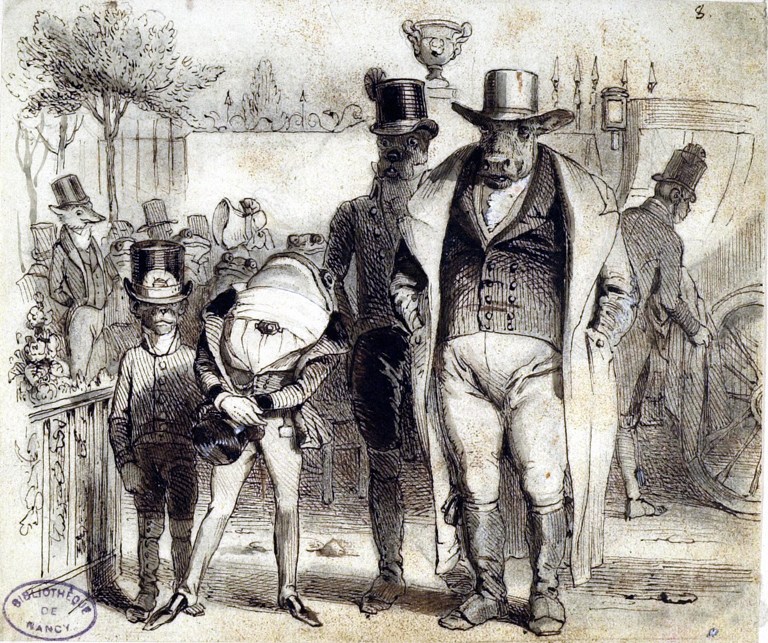This reading really struck a nerve for me. Despite already being aware of the marginalisation of animals, the use of their symbolism, their gradual extinction and the unnatural environment of zoos I had never really understood the true tragedy of the separation of man and animal. That is, man and animal becoming an “us” and “them” relationship over time.
(I somewhat condensed and summarised the reading, adding my own thoughts)
The reading suggests that animals didn’t first enter the human imagination as meat or leather products, but as messengers and promises.
- “Animals are born, are sentient and are mortal. In these things they resemble man”.
- “What know what animals do and what beaver and bears and salmon and other creatures need, because once our men were married to them and the acquired this knowledge from their animal wives”. (Hawaiin Indians quoted by Levi-Straus in The Savage Mind)
– The quotes John Berger uses so beautifully reflect the points he makes throughout the reading
He suggests that the “abyss” between two men are bridged by language – even if no words are used, the existence of language allows them to understand each other whereas this does not apply to animals, their is a further distance and incapability of men and animal understanding each other.
It’s the lack of common language and the animals silence that guarantees it distance, distinctness and exclusion from man.
Man and animal both come from a long evolutionary line, it can be said that man was once animal, or still is. Animals interceded between man and their origin because they were both like and unlike man. The clear difference between man and animal is just as distinct as the clear similarities.
- “Animals came from over the horizon”
The author explains that those who live closely with animals may become fond of them, but fondness of animals doesn’t change their purpose. A peasant may become fond of his pig and sell it’s pork, the two statements in that phrase are connected by an and not a but.
Berger also explains the use of animals as an icon, as a representation of character by which man can use to explain themselves – for example, the courage of a lion or the sneakiness of a mouse. Animals offered explanations and lent their name and character to man.
- “Some of these qualities in man, as compared with the corresponding qualities in animals, differ only quantitatively: that is to say, man has more or less of this quality, and an animal has more or less of some other”.
Animals, over time, have been severely marginalised. Man has raised himself above the state of nature, and animals have fallen below it. Man conquered animals turned them into slaves, or treated them as rebels. Animal societies have faded away, their industries have become unproductive and each species has lost it’s general qualities. All that remains of animals is their distinct capabilities developed either through imitation and education, or by fear and necessity during the constant watch for survival.
- “What visionsand plans can these soulless slaves have, these relics of the past without power?”
- “Only vestiges of their once marvellous industry remain in far deserted places, unknown to man for centuries, where each species freely used its natural capacities and perfected them in peace within a lasting community. The beavers are perhaps the only remaining example, the last monument to that animal intelligence . . . ”
It was super saddening to read these views on the marginalisation of animals and see the reality in the amount of power and independence they have lost. These are all of the ways that man has repressed animals that I could think of:
– Invention of the railway, electricity, the canning industry, cars, chemical fertilisers
– Land clearing displacing animals
– Countrysides transformed into suburbs where field animals once thrived
– The commercial exploitation of species (bison, tigers, reindeer)
– Poaching
– Animal experimentation
Part of the reduction of the animal is commercial farming, where they are treated merely as slaves and have lost all past recognition as being unlike, but also much like man. Over time ideas of the value of animals has disintegrated. Animals are often seen in numbers, as cattle in a farm, or as the little number of them remaining at all.
Another interesting point made in the reading was the domestication of animals. It was amazing to read that in the US, there are at least 40 million dogs and cats and millions of other pets. The domestication of animals prevents them from accessing space, earth, grass, soil, fresh water, other animals, seasons and natural temperatures. The pet is sterilised, sexually isolated, limited in exercise, deprived of almost all other animal contact and fed artificial food.
Berger also explores the idea of a pet ‘completing’ you – offering a mirror to a part that is otherwise never reflected – but in this the autonomy of both parties is lost. The owner has become “the special man he is only to his pet”, and the animal is completely dependent on its owner for every physical need. The parallelism of their separate lives is destroyed.
The word ‘animal’ has lost it’s central importance and meaning. We group pets into “family” and all other animals are transformed into human puppets for example, for Disney animal productions.
https://www.youtube.com/watch?v=eQVR-LSja68
Animals have been “Absorbed into the silent majority” – we use them as symbols in a human world and the value of the actual animal is irrelevant.
“All animals are entirely visible to man, but their landscapes will never be entered by the spectator. All animals appear like fish seen through the plate glass of an aquarium.”
Animals are always the observed. The fact that they can observe us has lost all significance. They are only the objects of our ever-extending knowledge and what we know about them is an index of our power and thus an index of what separates us from them. The more we know, the further away they are – they have been turned into a pure spectacle.

Grandville’s animal drawings, where they are dressed up as men and women – here animals aren’t being used as reminders of original or as metaphors, but being used to portray “people” situations (The movement that ends with the ‘banality’ of Disney)
“Goodnight then, dear reader. Go home, lock your cage well, sleep tight and have pleasant dreams. Until tomorrow.”
Zoos were said to have the function of furthering knowledge and public enlightenment, yet was it possible to study the natural life of animals in such unnatural conditions?
The reading made me think of the common question of “What is your favourite animal?” – this further sort of demonstrates the idea of animals simply being observed by man as their character rather than as individual beings. They are somewhat seen as a product of human society.
In a zoo you are looking at something that has been rendered absolutely marginal and all the concentration you can muster will never be enough to centralise it.
In zoos, animals are free but within strict limits. Visibility, space, air have been reduced to tokens. The decor for the animal acts as pure illusion – painted walls and rock pools at the back of boxes for small animals suggests something of the animals natural landscape – artificial rocks for bears, pebbles and shallow water for crocodiles. These tokens act as theatre props to the spectator, but for the animal they constitute the bare minimum of an environment in which they can physically exist. These animals have become completely dependent upon their keepers, most of their natural responses have been changed – they are passively waiting for a series of arbitrary outside interventions.
- The space which they inhabit is artificial
- The light is artificial
- Their environment is illusory
- Nothing surrounds them but their own lethargy or hyperactivity
- They have nothing to act upon (except briefly supplied food or a supplied mate)
- Their dependence and isolation have conditioned their responses
All in all this reading was super interesting, depressing and eye-opening all at once. Berger makes some great points and highlights some very serious issues that were previously invisible to me. He writes in such a way that makes you look at the world in a different light, it made me feel like I needed to swallow my ego and aura of self-importance and look at the earth as it is and as it always has been – full of natural wonder and without man being of central importance.












